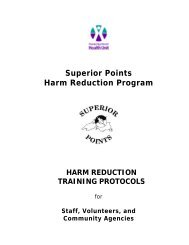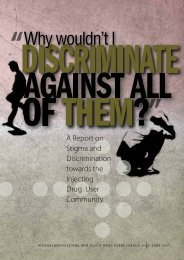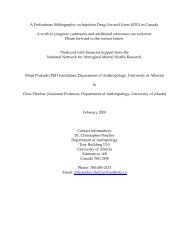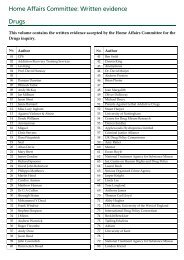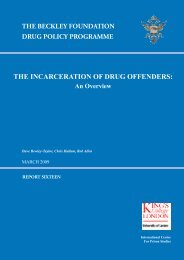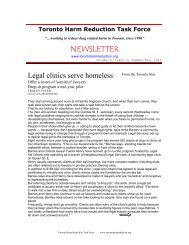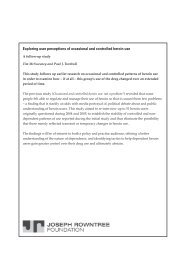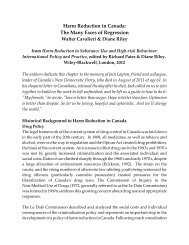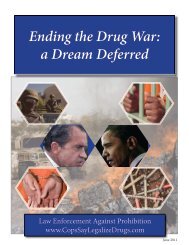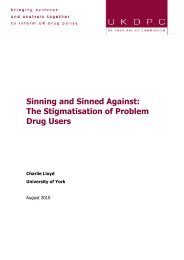Canadian Journal Addiction Medicine - Canadian Harm Reduction ...
Canadian Journal Addiction Medicine - Canadian Harm Reduction ...
Canadian Journal Addiction Medicine - Canadian Harm Reduction ...
You also want an ePaper? Increase the reach of your titles
YUMPU automatically turns print PDFs into web optimized ePapers that Google loves.
the<br />
<strong>Canadian</strong> <strong>Journal</strong> of<br />
<strong>Addiction</strong> <strong>Medicine</strong><br />
an official publication of the <strong>Canadian</strong> Society of <strong>Addiction</strong> <strong>Medicine</strong><br />
Canada’s first national Low Risk Drinking Guidelines address<br />
1) situations in which to avoid alcohol, 2) long term health<br />
risks, 3) short term health risks of injury or harm, 3) pregnancy<br />
and 4) youth. The presentation explores the scientific basis for<br />
the guidelines, reviews the guidelines themselves, and opens<br />
discussion on the challenges of knowledge translation. The<br />
creation of “a culture of moderation” will reduce alcohol<br />
related harms and provide greater opportunity for earlier<br />
interventions.<br />
Distress Tolerance Skills in 15<br />
Minutes<br />
Dr. Mark Weiss B.Sc., MD<br />
Bellwood Health Services<br />
Teaching clients with mental health disorders to regulate<br />
their emotions can greatly benefit the therapeutic alliance.<br />
The challenge is how to teach simple distress tolerance skills<br />
within a 15 minute time frame that might allow clients “to ride<br />
the wave of difficult emotions” without engaging in harmful<br />
behaviours. Dialectical Behavioral Therapy developed by<br />
Marsha Linehan is an evidenced-based treatment for clients<br />
with borderline personality disorder, which has developed a<br />
series of skills to help clients learn to cope with distress. These<br />
skills can be enormously beneficial to clients with a history<br />
of addiction, trauma or mood disorders. This workshop will<br />
present an approach to teaching simple and basic distress<br />
tolerance skills that can be taught in your office within a five<br />
to fifteen minute time frame. These skills will include learning<br />
to use simple breathing techniques, distractions, self-soothing,<br />
as well as other techniques that can be added to a client’s<br />
repertoire on an incremental basis on each visit.<br />
This workshop would be useful for physicians or other health<br />
care professionals seeing patients in a variety of settings<br />
including a primary care or psychotherapeutic setting.<br />
The Emergence of Bath Salts<br />
as a Drug of Abuse<br />
Jag Khalsa, PhD, MS, Chief, Medical Consequences, National<br />
Institute on Drug Abuse, NIH, Bethesda, MD, USA<br />
Substance abuse remains a major problem in the world with<br />
an estimated 200 million people 12 years or old who use<br />
an illicit drug, with >19 million current substance abusers<br />
in the US alone. Use/abuse of legal (alcohol, tobacco) and<br />
illegal drugs (amphetamines, cocaine, opiates, marijuana etc.)<br />
costs the American society an estimated $1 trillion annually.<br />
Substance abuse is associated with serious adverse medical/<br />
health consequences affecting almost every physiological<br />
system. As if we did not have enough problems with the current<br />
‘5 drugs’ illicit drugs [amphetamine/methamphetamine,<br />
cocaine, opiates, and marijuana], now we have an emerging<br />
problem with new designer synthetic marijuana alternatives<br />
like K2 or Spice) and synthetic cathinones, commonly called<br />
‘BATH SALTS’, containing the active chemical constituent,<br />
mephedrone, that has CNS stimulant properties similar<br />
to amphetamines. This presentation will discuss/review<br />
epidemiology (incidence, prevalence), pharmacology, and<br />
associated clinical as well as other consequences of ‘Bath<br />
Salts’ and KHAT, a plant whose leaves and twigs as chewed<br />
for their reported amphetamine-like euphoric effects, and<br />
research efforts that are being made at NIDA/NIH.<br />
References: (1). Rosenbaurm CD et al., Here today, gone<br />
tomorrow…and back again? A review of herbal marijuana<br />
alternatives (K2, Spice), synthetic cathinones (bath salts), kratom,<br />
Salvia divnorum, methoxetamine, and piperazine., J. Med<br />
Toxicol. 2012, (1): 15-32. (2). Fass et al. Synthetic cathinones<br />
(bath salts): legal status and patterns of abuse, Ann Pharmacther.<br />
2012; 46(3): 436-441. (3) Prosser, JM and Nelson, LS. The<br />
toxicology of bath salts: a review of synthetic cathinones, J Med<br />
Toxicol. 2012, 8(1): 33-42.<br />
Primary Care Approaches to<br />
<strong>Addiction</strong>s<br />
Dr. Ashok Krishnamurthy<br />
This talk will explore the important role of primary care<br />
providers in screening for, briefly intervening and motivating<br />
their patients to address their addictions. The rationale for<br />
these interventions, simple screening tools will be discussed.<br />
Select cases will be used to illustrate by example the issues<br />
at hand.<br />
Benzodiazepines<br />
Dr. Ramm Hering<br />
After opioids, benzodiazepines are one of the most<br />
abused and problematic prescription or illicit drugs. This<br />
talk will introduce benzodiazepines by briefly reviewing<br />
pharmacology, indications, harms (including tolerance and<br />
withdrawal), of benzos. More time will be spent on issues<br />
19<br />
Volume 3 No. 2




